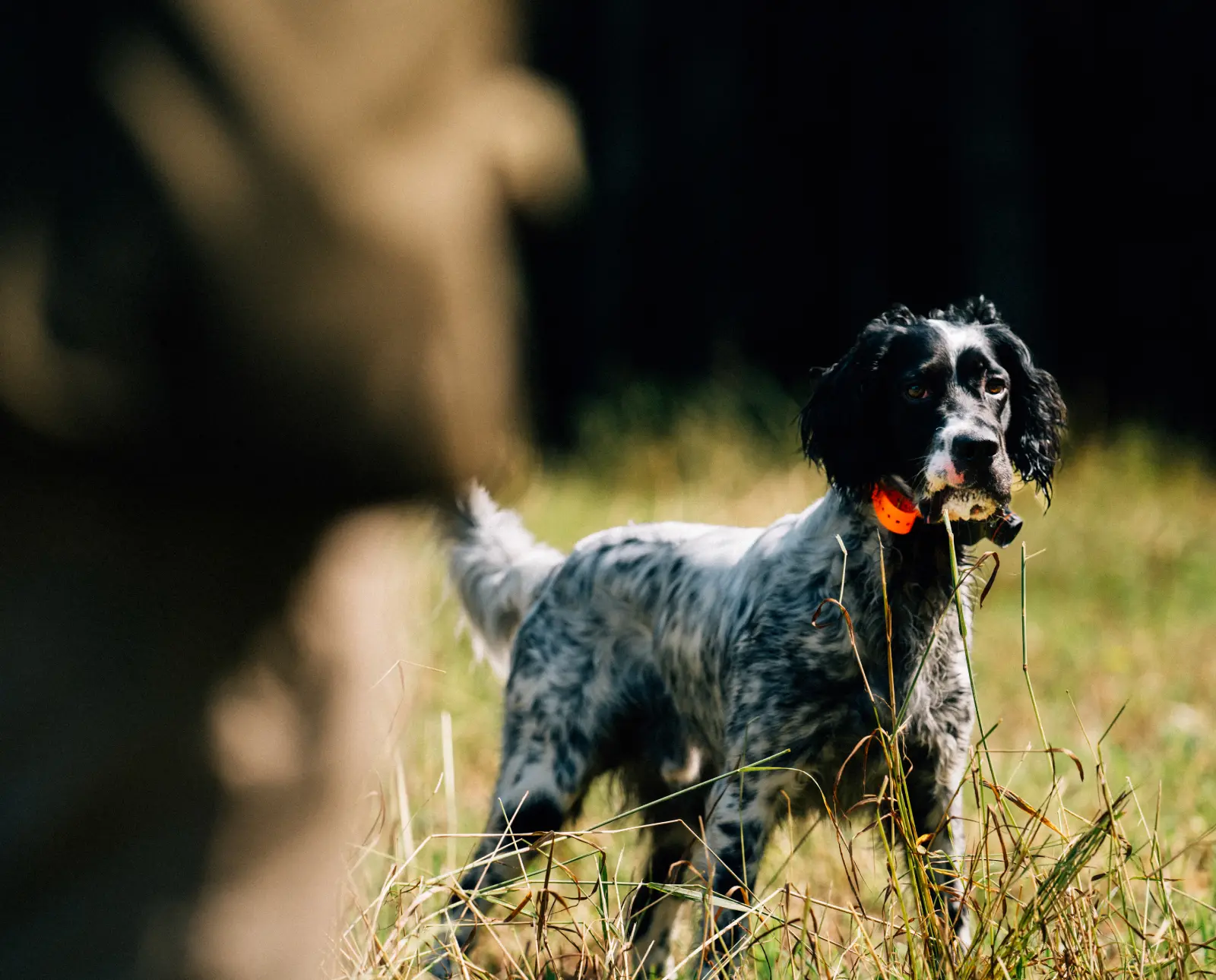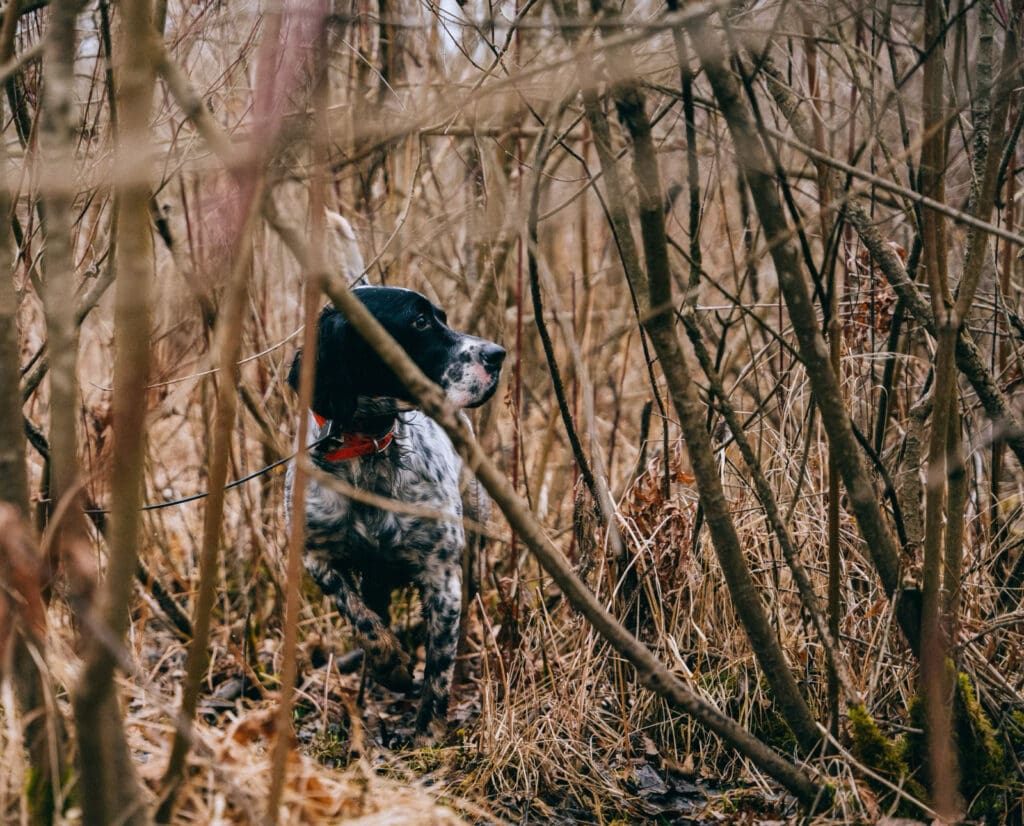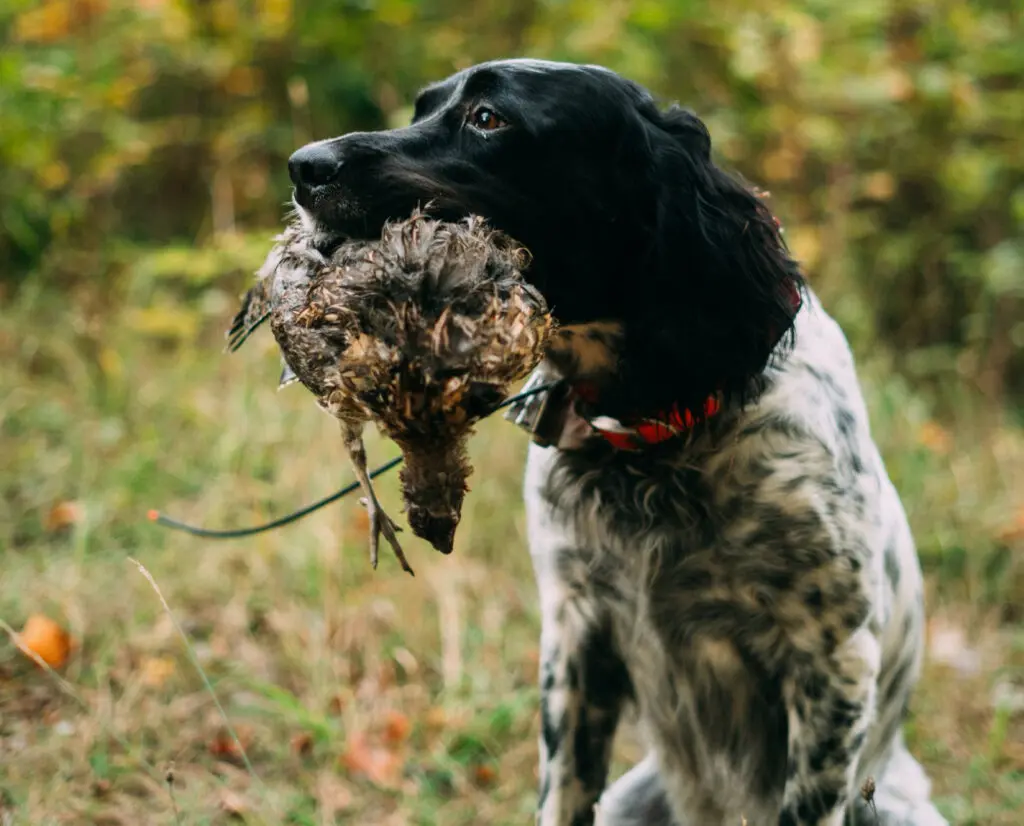Home » Hunting Dogs » English Setter: Characteristics, Abilities, and History
English Setter: Characteristics, Abilities, and History

Gabby Zaldumbide is Project Upland's Editor in Chief. Gabby was…
The intelligent and beautiful English Setter is an international phenomenon in the bird dog world that still holds strong for this hunting breed.
“And if gunning over an intelligent handsome setter enriches my sport, certainly a hearthful of them on a winter evening or speckled faces peering out of our station wagon are things to value.”
George Bird Evans
Listen to more articles on Apple | Google | Spotify | Audible
The English Setter was America’s first bird dog. And rightly so; they’re known for being incredible hunting partners regardless of the terrain or quarry. As a result, they have a long history in North America, and evidence of that can be found in classic upland bird hunting texts like The Upland Shooting Life by George Bird Evans. However, this dog breed was originally developed across the Atlantic Ocean in England.
Rather ironically, the more time passes, the less English the English Setter has become. “Wildly popular in some regions, more or less unknown in others, they face extinction in their native land,” says Craig Koshyk in his book Pointing Dogs Volume Two: The British and Irish Breeds. Over 15,000 pups are born in Italy each year, and only 250 are born in England. Italy, France, and Norway have taken the English Setter as a breed and ran with it, and their “influence on the development of the breed cannot be overstated,” said Koshyk.
Whether you’re considering bringing an English Setter into your home or you’ve hunted over this breed for decades, it’s easy to see how their gorgeous looks, incredibly friendly temperaments, and undeniable desire to hunt have allowed their popularity to skyrocket. Let’s look deeper into the English Setter’s history, characteristics, and hunting abilities by glancing into Pointing Dogs Volume Two’s chapter on English Setters.

English Setter Characteristics and Form
| Characteristics | Details |
| Name | Since 1872: English Setter Pre 1872: English SpanielGermany: Der English SetterFrance: Le Setter anglaisItaly: Il setter ingleseRussia: angliīskiī setter |
| Size | Males: 25.5-27 inchesFemales: 24-25.5 inches |
| Tail | Not docked, feathery |
| Coat | Flat-lying and short or thick, abundant coats. May have a top knot |
| Coat Color | Wide variety. Typically blue belton, orange belton, and tricolor. In Europe, liver-and-white is also common |
| Health Issues | Hip dysplasia, elbow dysplasia, deafness, hypothyroidism. Some lines may be prone to epilepsy, Osteochondritis dissecans (OCD), and progressive retinal atrophy (PRA) |
| Character | Absolute sweethearts |
| Population | Approximately 30,000 whelped annually |
| Range | Big-running |
| Pace | Most strains are fast; a few are more moderate |
| Good Choice For | Grouse, woodcock, pheasant, quail, chukar, Huns, ptarmigan, snipe, waterfowl |
English Setters are wildly popular worldwide thanks to their delightful personality, medium size, and impressive hunting abilities. Expert dog trainer Curtis Fry told Craig Koshyk that their personality is the main reason he owns the breed. “They run the gamut from goofy to elegant, but most are calm in the house, and docile when you are feeling down, but full of energy in the field where they run like the wind,” he said. Their lovely disposition, combined with their trainability, are what allowed Fry to take multiple English Setters to the highest levels in NAVHDA tests.
Regarding field-bred dogs and show-bred dogs, the ones bred for the field are smaller. However, Koshyk has found that English Setters have more variation than any other bird dog breed. For example, Ryman Tyle and American Old Hemlock Setters can be larger. Scandinavian Setters are very middle-of-the-line, and Italian and American Setters are on the lower end of the standard. Their coats vary as much as their sizes, too.
“An important contributor to the success of the English Setter is the wide range of coat colors and patterns that have always been accepted in the breed,” said Koshyk. This allows English Setter breeders to focus more on abilities and temperament than color. They must always have a white ground, but their flecking or spots range from black and liver to lighter shades like lemon, tan, and orange. Today, this Setter is most commonly found in blue belton, orange belton, and tricolor.
The Field Dog Stud Book defines a belton coat as “all white, but ticked with a secondary color or colors.” If a Setter has a large patch or patches of any color, that dog will not be described as belton. Instead, it’s deemed orange-and-white, black-and-white, liver-and-white, or tricolored.
Coat lengths can vary as much as coat colors. “Some strains have flat lying, relatively short coats,” said Koshyk. “Others have thick, abundant coats and even a topknot.” Show-bred dogs tend to have longer coats and field-bred dogs usually have shorter coats. Some hunters and field trailers will even shave their dog’s coat before the season if the conditions are expected to be hot.

English Setter Training and Hunting Ability
Regarding trainability, English Setters can be soft to anything but. Scott Berg, who’s been breeding English Setters in America for over three decades, argues that “they are on the softer side, but in some ways that means they can be easier to train, if you understand their mental makeup.” Alternatively, Fry states, “I’ve had some that were soft. So for me, it is more of a question of how you approach their training. They are generally a bit slower to develop than Pointers but you can’t really generalize. You have to train them as individuals.”
Whether you’ve got a soft or hard-headed Setter on your hands, allowing them to have and enjoy puppyhood is important to the dog training process. The President of the English Setter Club of England, Dom Gotourbe, told Koshyk that “starting them too early and not letting them have a puppyhood are common mistakes.” He’s found that the best way to train English Setters is to maintain a sense of humor. “You have to remember that you are training a dog and not programming a robot,” he said. “A close bond with your dog is essential.” Thankfully, their most important skill–pointing–is inherently strong.
Pointing comes naturally to many English Setters, and backing does, too. Some Setters start pointing as early as eight weeks old; others might take 11 to 12 months. Regardless of when your Setter starts pointing, anyone can notice the significant difference between regional pointing postures.
“Traditionally, especially in the days of hunting with nets, setters were expected to lay down on point,” said Koshyk. Laying or crouching is still the preferred pointing posture for Italians. In the UK, Scandinavia, France, and beyond, both breeders and professional judges prefer “a more upright point, with the dog standing up or only slightly crouched,” according to Koshyk. Comparatively, American English Setter breeders require a “high on both ends” pointing style. In this position, the dog is standing up with its head held high and its tail at 12 o’clock.
Field Search
The English Setter’s field searching styles have evolved over time. In the past, Setters were slower and closer-working, even though they were considered fast and wide-ranging back then. Today, they are much quicker and work wider than in the past, but their running style has a wider variety based on their region and line.
“There is a lot of variety in the breed and it really depends on how you develop an individual dog,” said Scott Berg. “If a dog is biddable, handles well, and stays connected to the handler, it can cover a lot of ground and still be in control.”

Retrieving and Water Work
Before field trials existed, English Setters were always expected to retrieve. Setters that didn’t retrieve naturally were generally unwanted. Modern Europe still always expects their English Setters to retrieve while hunting. Across the pond, they even have specific formats of field trials that require Setters to retrieve.
Curtis Fry told Koshyk that “if you select for intelligence and cooperation, then retrieving comes easily…I want a clean and absolutely reliable retrieve.”
Fry also has much to say about the English Setter’s ability to perform in the water. “If I have a dog that loves birds–and it is tough to find an English Setter that doesn’t love birds–water work then becomes the same as retrieving, which they love.” He continues, explaining how early exposure to water often yields positive results. “Once they get used to water, it becomes no big deal.”
English Setter History and Development in America
When thinking about historically significant English Setter lines that influenced this dog’s existence in America, four specific strains come into play: Laverack, Llewellin, Ryman, and Old Hemlock.
Laverack Setters
“The first thing to be attended to in breeding is to consider what object the animal is intended for.” – Edward Laverack
Edward Laverack is known as the father of the modern English Setter. He authored one of the earliest histories of the breed in the book titled The Setter, published in 1872. He grew up in Scotland, where he spent his early years shooting over the country’s moors and bought his first brace of dogs in the 1820s. The first pair of Laverack Setters sent by Edward Laverack himself arrived in America in 1874.
Although Laverack Setters were not favored by southern or western bird hunters or field trialers, they had an incredible ability to pin birds in the Northeast and to win dog shows. “Technically, when Mr. Laverack died in 1877, the Laverack ‘breed’ died with him, and since the pedigrees he presented to the Kennel Club were no longer considered 100 percent accurate, no agreement could be reached about what a ‘true’ or ‘pure’ Laverack actually was,” said Koshyk.
Llewellin Setters
Richard Purcell-Llewellin created his strain of Setters with pure Laveracks and dogs with “steady nervous system, brains, and absence of all excitement.” As a result, he produced fast, wide-running dogs that were trainable and easy to handle. He continued to breed dogs for 50 years, and they became very popular in America.
However, the Field Dog Stud Book listed Llewellins as a separate breed, not strain. “The idea that Llewellin Setters were an independent breed, not just a strain of English Setters, had taken hold, and for some, it still holds today,” said Koshyk.
Ryman Setters
George Ryman is a famous dual-type English Setter breeder who started his line of “cover dogs” in Pennsylvania in the early 1900s. By 1920, he had a kennel of at least 100 dogs, and all of them “were the sportsman’s dog,” according to Freeman Lloyd.
There is no greater authority today on the Ryman Setter than Walter Lesser, author of The Real Ryman Setter. Ryman sought to “produce a certain type of setter, and he crossed to any dogs that would produce that type for him,” said Walter Lesser, someone who actually saw dogs bred by Ryman. “Constand introduction of new bloodlines was a hallmark of George Ryman’s breeding program, and it is an obvious feature of any of his pedigrees.”
Ryman continued to breed and sell dogs until, in 1955, at the peak of his success, he “suffered from a debilitating stroke,” said Koshyk. “His wife Ellen took over the day-to-day operations of the kennel and cared for George, who eventually passed away in 1961.” Today, folks can still find dogs that are said to be Rymans; however, a true Ryman Setter could only be one bred by the man himself.
Old Hemlock Setters
George Bird Evans developed his own line of dual-type setters, similar to George Ryman, in the 1950s. Evans and his wife started with dogs from Ryman, creating their own line of “companion gundogs.”
“In our way, we were doing what had been done in England years ago when country places bred their private strings of setters, shaped by types of shooting,” Evans wrote in an article in Field and Stream from 1971. “Beyond this personal gratification that lifts shooting with a dog to a plane above simply killing birds, if more shooting men would develop private strains of gundogs aimed at what they feel a gundog should be, ruffed grouse and woodcock dogs that hunt to the gun would once again be more than a memory.

English Setter Clubs
The English Setter Club (UK, 1890)
The English Setter Association (UK, 1951)
The English Setter Club of Ireland
The English Setter Association of America
The English Setter Club of Canada
Club du Setter Anglais (France)
Società Italiana Setters (Italy)
Eesti Setterite Klubi (Estonia)
English Setter Club of Netherlands
Österreichischer Setter Club (Austria)
Verein für Pointer und Setter e.V. (Germany)
Setter und Pointer Club Schweiz (Switzerland)
Svenska Setterklubben för Engelsk Setter (Sweden)
Norsk Engelsksetterklubb (Norway)
Engelsk Setter Klub I Danmark (Denmark)
Gabby Zaldumbide is Project Upland's Editor in Chief. Gabby was born in Maryland and raised in southern Wisconsin, where she also studied wildlife ecology at the University of Wisconsin-Madison. In 2018, she moved to Gunnison, Colorado to earn her master's in public land management from Western Colorado University. Gabby still lives there today and shares 11 acres with eight dogs, five horses, and three cats. She herds cows for a local rancher on the side.




Great article on setters. As my 13 year old female setter sleeps beside me as I write this comment I have sadness in my heart, but also dreams about a new setter when that time will surely come to pass.
5000 foot elevation of Pike county kentuck in the 1970’s offered quail & grouse. And long-haired Rebel gave us retrieves in the fields and the sound of drumming on the mountains. The strenuous hillside work developed an ‘athletic heart’ in these individual; astonishingly large heart from a life time of climbing. Easily trainable, maybe because he wanted to please, just like any friend would. Calm behavior , as compared to a pointer, isn’t better or less of an attribute but only calmer. And his companionship in the home made dog hair in the dinners wholly acceptable. He was a love. What a class act, ‘ol Reb